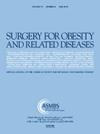Effects of sleeve gastrectomy on populations with obesity and obstructive sleep apnea: a meta-analysis
IF 3.8
3区 医学
Q1 SURGERY
引用次数: 0
Abstract
Background
Obstructive sleep apnea (OSA) is highly prevalent in patients with morbid obesity, prompting interest in bariatric surgery as a potential management strategy. Sleeve gastrectomy (SG), being the primary bariatric surgical option, offers simplicity, reduced postoperative complications, and favorable outcomes for obesity and its associated conditions.
Objectives
This study aims to assess the efficacy of SG in treating populations with obesity and OSA.
Setting
University-affiliated hospital, China.
Methods
We conducted a comprehensive literature search across PubMed, Embase, Cochrane Library, and Web of Science databases to identify pertinent studies published up to March 28, 2024. Our review encompassed studies that assessed the effectiveness of SG on primary outcomes, including the apnea-hypopnea index (AHI), as well as secondary outcomes such as forced vital capacity (FVC), forced expiratory volume in the first second (FEV1), nonrapid eye movement sleep stage 3 (NREM 3), rapid eye movement sleep (REM), sleep efficiency (SE), arousal index, Epworth sleepiness scale (ESS), oxygen desaturation index (ODI), apnea index (AI), meanSpO2, body mass index (BMI), weight, neck circumference (NC), waist circumference (WC), waist-to-hip ratio (WHR), subcutaneous fat area (SFA), visceral fat area (VFA), systolic blood pressure(SBP)/diastolic blood pressure(DBP), and measurements related to glucolipid metabolism. A total of 12 eligible studies underwent a systematic screening process and were subsequently subjected to meta-analysis using either randomized effects model or fixed-effect models.
Results
Significant reductions in AHI, BMI, weight, SFA, and VFA were observed following SG. Correspondingly, enhancements in FVC, meanSpO2, NREM 3%, REM%, and SE, were noted after SG. Additionally, the populations with obesity and OSA exhibited decreases in arousal index, ODI, AI, ESS, NC, WC, WHR, and DBP post-SG. Moreover, reductions in HOMA-IR and glycosylated hemoglobin were also observed after SG.
Conclusion
SG demonstrates favorable outcomes in the populations with obesity and OSA.
袖带胃切除术对肥胖和阻塞性睡眠呼吸暂停人群的影响:一项荟萃分析。
背景:阻塞性睡眠呼吸暂停(OSA)在病态肥胖患者中非常普遍,这促使人们将减肥手术作为一种潜在的治疗策略。袖带胃切除术(SG)作为主要的减肥手术方案,具有操作简单、术后并发症少、治疗肥胖症及其相关疾病效果好等优点:本研究旨在评估 SG 对肥胖症和 OSA 患者的治疗效果:研究地点:中国大学附属医院:我们在 PubMed、Embase、Cochrane Library 和 Web of Science 数据库中进行了全面的文献检索,以确定截至 2024 年 3 月 28 日发表的相关研究。我们的综述涵盖了评估 SG 对主要结果(包括呼吸暂停-低通气指数(AHI))以及次要结果(如用力肺活量(FVC)、第一秒用力呼气量(FEV1)、非快速眼动睡眠第 3 阶段(NREM 3)、快速眼动睡眠(REM)、睡眠效率(SE)、唤醒指数)的有效性的研究、Epworth嗜睡量表(ESS)、血氧饱和度指数(ODI)、呼吸暂停指数(AI)、平均SpO2、体重指数(BMI)、体重、颈围(NC)、腰围(WC)、腰臀比(WHR)、皮下脂肪面积(SFA)、内脏脂肪面积(VFA)、收缩压(SBP)/舒张压(DBP)以及与糖脂代谢相关的测量值。共有 12 项符合条件的研究经过了系统筛选,随后采用随机效应模型或固定效应模型进行了荟萃分析:结果:观察到 SG 治疗后 AHI、BMI、体重、SFA 和 VFA 显著降低。相应地,SG 后 FVC、meanSpO2、NREM 3%、REM% 和 SE 均有所提高。此外,肥胖和 OSA 患者在接受 SG 后的唤醒指数、ODI、AI、ESS、NC、WC、WHR 和 DBP 均有所下降。此外,SG 后还观察到 HOMA-IR 和糖化血红蛋白的降低:结论:SG 对肥胖和 OSA 患者有良好的疗效。
本文章由计算机程序翻译,如有差异,请以英文原文为准。
求助全文
约1分钟内获得全文
求助全文
来源期刊
CiteScore
6.70
自引率
12.90%
发文量
570
审稿时长
56 days
期刊介绍:
Surgery for Obesity and Related Diseases (SOARD), The Official Journal of the American Society for Metabolic and Bariatric Surgery (ASMBS) and the Brazilian Society for Bariatric Surgery, is an international journal devoted to the publication of peer-reviewed manuscripts of the highest quality with objective data regarding techniques for the treatment of severe obesity. Articles document the effects of surgically induced weight loss on obesity physiological, psychiatric and social co-morbidities.

 求助内容:
求助内容: 应助结果提醒方式:
应助结果提醒方式:


